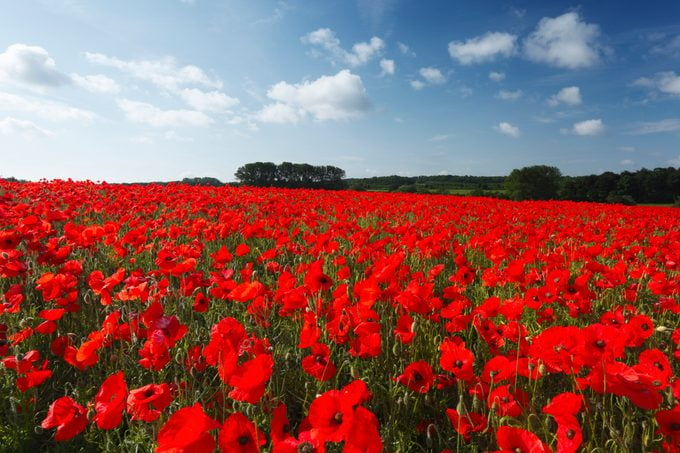When Is Memorial Day 2024, and Why Do We Celebrate It?
Updated: Apr. 10, 2024

It's not just the unofficial beginning of summer. Read up on this holiday's meaning and history before Memorial Day 2024 arrives.
Memorial Day is observed each May, but how many of us actually know what Memorial Day is truly about—or its history? Some observe Memorial Day by doing things like visiting the graves of fallen soldiers and sharing meaningful Memorial Day quotes on social media, while others host a barbecue at the beach, shop sales at stores open on Memorial Day or pick up food at restaurants open on Memorial Day. But why do we take part in these activities, and how did this holiday come to be? Before Memorial Day 2024 weekend gets here, read up on the holiday’s meaning and history (and don’t forget to brush up on the difference between Memorial Day and Veterans Day).
What is Memorial Day
Memorial Day is considered a federal holiday in the United States, in which we honor and mourn members of the military who have passed away while serving in the United States Armed Forces. On this day, we pay tribute to those who gave their lives while protecting and serving their nation.
When is Memorial Day?
Memorial Day was witnessed on May 30 from 1868 until 1970 but is now observed annually on the last Monday in May. What day does Memorial Day fall on this year? In 2024, Memorial Day occurs on Monday, May 27, and it will fall on these dates in the coming years:
- May 26, 2025
- May 25, 2026
- May 31, 2027
Is Memorial Day always the last Monday in May?
Yes, Memorial Day falls on the last Monday in May. In 1971, the date of the holiday was officially changed to the last Monday in May, per the Uniform Monday Holiday Act. This act also moved other holidays, such as Presidents Day and Martin Luther King Jr. Day, to consistently be on Mondays.
The history of Memorial Day
Originally known as Decoration Day, Memorial Day began with an idea from General John Logan as a way to honor the fallen soldiers of the Civil War. The first celebration on May 30, 1868, was held at Arlington National Cemetery, with a crowd of 5,000 people decorating the graves of more than 20,000 military personnel with flowers. Most experts believe General Logan planned the first Decoration Day for that day because northern and southern states would have flowers in bloom by then, though others believe the date was ideal because it didn’t coincide with the anniversary of any battles.
Various Washington officials, including General Ulysses S. Grant, presided over the ceremonies. After speeches, children from the Soldiers’ and Sailors’ Orphan Home, among others, made their way through the cemetery, strewing flowers on both Union and Confederate graves, reciting prayers and singing hymns. Many also came prepared with a picnic lunch.
It wasn’t until after World War I that Memorial Day was expanded to honor all veterans who died in any American war. In 1971, Decoration Day became officially known as Memorial Day, and Congress passed an act declaring it a national holiday. That same year, Memorial Day was moved by President Lyndon B. Johnson from May 30 to the last Monday in May. “This will … enable families who live some distance apart to spend more time together,” President Johnson noted in his official statement regarding what is now known as the Uniform Monday Holiday Act.
New York was the first state to declare Memorial Day an official holiday, followed by other northern states, but the southern states had their own designated day to honor fallen Confederate soldiers. The observances remained separate until after World War I, when Memorial Day was changed to honoring the fallen Americans who fought in any war. Some southern states continue to honor the Confederate dead: January 19 in Texas; April 26 in Alabama, Florida, Mississippi and Georgia; May 10 in North and South Carolina; and June 3 in Louisiana, Kentucky and Tennessee.
Why don’t we say “Happy Memorial Day”?
While it’s tempting to say “Happy Memorial Day,” and you may not have ill intent when saying it, it’s important to remember the meaning of the holiday before you say this. Memorial Day is a day to honor those who sacrificed their lives while serving in the military. As the Code of Support Foundation points out, it’s a deeply personal day for many who lost loved ones in the service. Some think saying “Happy Memorial Day” puts the holiday in a more cheerful light, as opposed to the day of honor and remembrance it’s meant to be. Instead of saying “Happy Memorial Day,” the Code of Support Foundation offers an alternative phrase: “I wish you a meaningful Memorial Day.”
Memorial Day traditions

There are a number of Memorial Day activities that families enjoy participating in every year, but there are also a few meaningful Memorial Day traditions you can honor.
Memorial Day poppies: People wear poppies to honor America’s war dead in a Memorial Day tradition that dates back to the poem “In Flanders Fields,” written in 1915 by John McCrae. Inspired by the poem’s image of red poppies scattered among cross-shaped grave markers, American Moina Michael and France’s Anna E. Guerin started selling artificial poppies as a fundraiser for children affected by the war. Now, many Americans pin a poppy on their shirt as a sign of respect.
National Moment of Remembrance: To ensure that the sacrifices of America’s fallen heroes are never forgotten, President Bill Clinton signed into law “The National Moment of Remembrance Act” in December of 2000. The law encourages all Americans to pause wherever they are at 3 p.m. local time on Memorial Day for a minute of silence to remember and honor those who have died in service to the nation.
Hanging a flag at half staff: Federal guidelines say the flag should be displayed at half-staff only until noon, then go up to full-staff until sundown.
Playing “Taps”: During the Civil War, a U.S. general thought the bugle call signaling bedtime could use a more melodious tune, so he wrote the notes for “Taps” in 1862. Another officer later used the bugle song for a funeral, fearing the traditional firing of rifles might sound like an attack. Now, “Taps” is a traditional part of Memorial Day celebrations.
Visiting a local veterans cemetery: Some of the graves in a veteran cemetery are well maintained and decorated by families. Bring flowers and lay them by a grave that doesn’t have any. Or, you could volunteer to clean the graves of fallen soldiers.
Additional reporting by Kelly Kuehn.
Sources:
- The Army Historical Foundation: “General John A. Logan, Memorial Day Founder”
- TIME: “This Is Why Memorial Day Is a Three-Day Weekend”
- Code of Support Foundation: “Why You Don’t Say ‘Happy Memorial Day'”
- The American Legion: “The Poppy Story”
- U.S. Department of Veterans Affairs: “Guidelines for Display of the Flag”
- History: “How Did ‘Taps’ Originate?”



